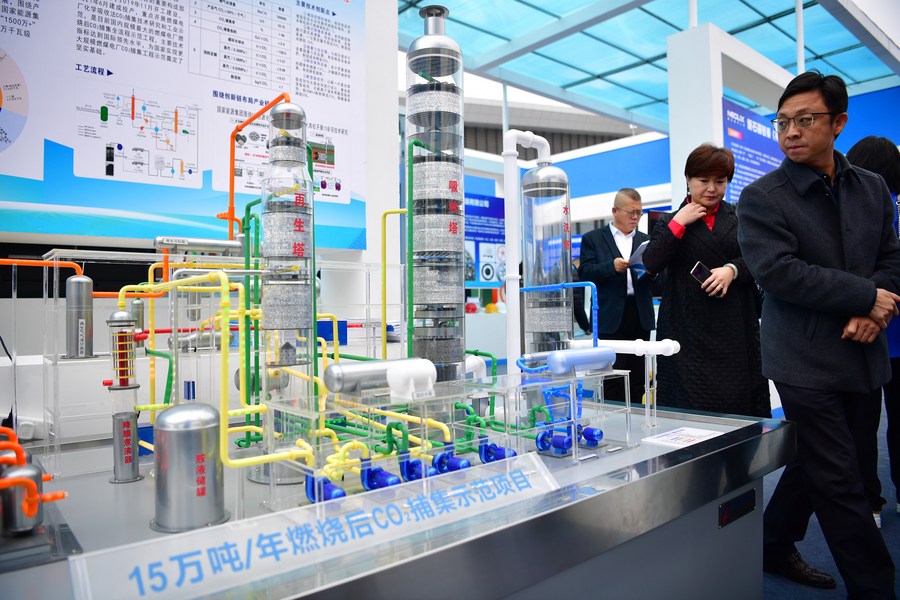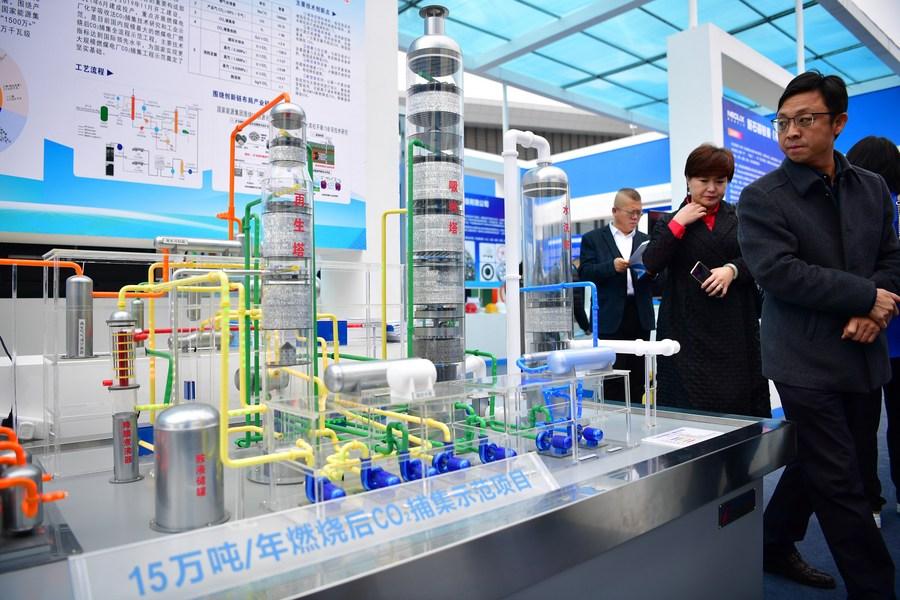
Visitors watch the model of a demonstration project for carbon dioxide capture, in an energy and chemical industry expo held in Yulin, northwest China's Shaanxi Province, Oct. 13, 2021. (Xinhua/Shao Rui)
BEIJING, Dec. 22 (Xinhua) -- Having set the goal of peaking its carbon dioxide emissions before 2030 and achieving carbon neutrality before 2060, China is now promoting energy conservation and emission reductions in various industrial sectors, including the traditional chemical industry.
The Ministry of Industry and Information Technology (MIIT) released a plan on Dec. 3 for the green development of its industrial sectors during the 14th Five-Year Plan period (2021-2025), a step forward in the country's pursuit of low-carbon growth.
The plan urges traditional sectors, such as petrochemistry, iron and steel, and non-ferrous metals, to carry out low-carbon upgrades and transform into greener industries.
Meanwhile, the annual Central Economic Work Conference this December pledged to strengthen the clean and efficient use of coal.
So far as the chemical industry as concerned, greener practices are getting a boost from the latest breakthroughs in chemical synthesis technology. This means that sub-industries such as fuel chemicals, inorganic chemicals and organic chemicals are becoming more environmentally friendly, with knock-on benefits across a wide range of sectors.
SCI-TECH BREAKTHROUGH
In 2021, Chinese researchers achieved several breakthroughs in chemical synthesis. These include a method of synthesizing starch from carbon dioxide, the first process of its kind globally, and a protein production method using industrial exhaust gas that contains carbon monoxide, carbon dioxide and ammonia water.
The progress in 2021 also includes converting carbon dioxide and water into pure formic acid, turning biopolyols into carbon monoxide at room temperature and atmospheric pressure, and producing ethylene by hydrogenation of acetylene under mild conditions.
At a ceremony in Beijing in November to honor China's distinguished scientists, engineers and research achievements, over 10 projects related to the petrochemical and coal chemical industries received awards. They included catalytic-cracking processing technology, the efficient exploitation of coalbed methane and rock oil, and crude-oil recovery.
Among them, the project of nano-confined catalysis won first prize in the State Natural Science Awards. This project realized the direct and efficient synthesis of light olefins and high-value chemicals such as ethylene, propylene and butene from coal-synthesized gas, with less water and energy consumption and lower carbon emissions.
Those achievements, ranging from laboratory experiment to industrial production, mean that basic materials for the chemical industry, such as ethylene, carbon monoxide, starch and protein, can be produced in a much greener way than traditional methods and with lower energy consumption and emissions.
HIGHER EFFICIENCY
The MIIT plan encourages the petrochemistry industry, a branch of the fuel chemical industry, to focus on direct production from crude oil and the use of coal-synthesized gas.
China Petroleum & Chemical Corporation (Sinopec), China's largest oil refiner, announced in November its success in the industrial application of crude oil steam-cracking technology, which can directly turn crude oil into ethylene and propylene by skipping the traditional refining procedure.
The traditional refining process can turn about 30 percent of crude oil into chemical products.
Using the new technology, 1 million tonnes of crude oil can produce about 500,000 tonnes of various chemicals, including about 400,000 tonnes of high-value products such as ethylene, propylene, light aromatics and hydrogen.
The crude oil catalytic-cracking technology, another technical route that Sinopec realized earlier this year, can also turn about 50 percent of crude oil into various chemicals. The combination of the two cracking technologies is expected to raise the turning rate to 70 percent.
China produced about 21.6 million tonnes of ethylene in 2020, with a growth rate of 5.25 percent year-on-year, according to the National Bureau of Statistics. Considering the scale of production, Sinopec's new method has the potential to save a huge amount of crude oil.
LOWER EMISSIONS
Supported by advanced technology, chemical plants in China have started to cut their carbon emissions. In Shanghai in east China, there is already a refinery that produces carbon-neutral products.
This September, the Shanghai Environment and Energy Exchange issued the country's first carbon-neutral petroleum certificate to a batch of refinery products made by Gaoqiao Petrochemical, a Sinopec subsidiary in Shanghai.
Those refinery products, made from 30,000 tonnes of crude oil, include gasoline, diesel, kerosene and liquefied petroleum gas that are all carbon-neutral.
Between 2018 and 2020, Gaoqiao Petrochemical completed 53 pollution control projects, significantly reducing the total emissions of major pollutants during production. The average emission concentration dropped to about 23 percent of the sector's standard limit.
This year, the company started projects such as colored smoke treatment, volatile organic compounds treatment, and ultra-low emission modification of heating furnaces to further cut emissions.
Besides emission-control measures, Gaoqiao Petrochemical is turning byproducts into clean energy.
In 2020, the company built a demonstration project to produce high purity hydrogen for fuel-cell vehicles from the byproducts of the refining plant. It plans to expand the hydrogen production line to provide 10 tonnes of hydrogen per day, enough to power 1,000 domestic fuel-cell cars to run 1,000 km.




 A single purchase
A single purchase









